|
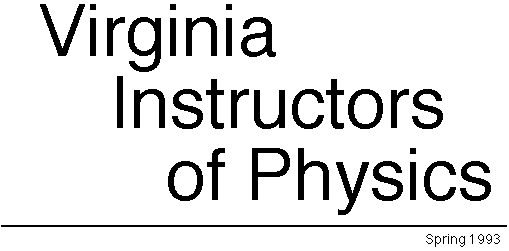
In this issue:
Fall meeting summary
- Election of officers
Spring meeting
Science Day at Kings Dominion
Physics Olympics at Kings Dominion
Science Day at Busch Gardens
Opportunities for Educational Growth
Kite Physics
Simple Harmonic Motion and the "Pit and the Pendulum"
Battery Powered Gyroscope from Junk
"Seeing the Light" -electrostatics demo
Non-Newtonian Fluids Update
Late Notes
Fall Meeting Summary
Minutes,Virginia Instructors of Physics Meeting, Fall meeting
University of Virginia Department of Physics, October 3, 1992, 9:00
am - 3:00 pm
The meeting was called to order by Tony Wayne who conducted the
election of officers. Those elected were:
President: Tony Wayne (Albemarle High School, Charlottesville)
Vice President: Brion Patterson (Rappahannock High School,
Sperryville)
Secretary: Frank Anderson (Woodbury Forest School, Woodbury
Forest)
Treasurer: Shawn Button
Topics discussed during the business meeting:
Newsletters will be mailed to all members during January, May and
August. All members are encouraged to make contributions to the
editor, Tony Wayne.
Affiliation with AAPT is desired and will be pursued by the officers.
It is also desired to have a working relationship with the Chesapeake
Section of AAPT.
The Spring meeting of VIP will be in March and possibly in Richmond.
Weekend meetings are preferred to weekday meetings.
VAST has agree to provide space for VIP at its next meeting. Brion
Patterson has agreed to be responsible for organizing the
distribution of pamphlets and information about VIP and AAPT.
Dr. Larson, Physics Department at UVa, expressed the Department's
strong desire to provide services for the physics teachers of
Virginia. This includes offering academic services as well as having
someone available to answer specific questions relating to physics,
equipment, demos, current developments, etc. This might be
accomplished by e-mail on VA-PEN (Public Education Network). How can
we best take advantage of this resource?
Dr. Richard Lindgren discussed funding for the Physics Summer
Institute for 1993. Last summer 16 teachers attended five weeks in
Charlottesville, earned 3 graduate credits in both education and
physics. These teachers were also provided housing and a $1200
stipend. The 1993 session will only be four weeks and is tentatively
scheduled for July. Expect a flyer from UVa in early Spring.
Possible menu options suggested for the new VA-PEN software:
Science.Physics, Software Archives, Manufacturer's Contact, Cutting
Edge (What's new in physics research?), Ask the Prof, VIP, NEWTON,
Demonstrations, Test Bank, Physics.List.
There was a a discussion of Physics Days at both Bush Gardens and
Kings Dominion. It was pointed out that it is difficult to get
students to attend on Saturday days due to other commitments in the
Spring.
Radon testing was discussed by Brion Patterson.
Tony Wayne presented the mechanics and philosophy of Science Week at
Albemarle High School and a $1.00 battery operated, hand held
gyroscope.
Jackie Hardy did two demonstrations on resonance and
electrostatics.
Dr. Tim Sigmond gave an extensive presentation of the VA-PEN system
and how it can be used effectively by teachers. The system is free to
educators. Contact your local computer coordinator or Doug Wells (Va.
Dept. of Ed.) at 804-979-6347.
The membership of VIP is most grateful to Dr. Bascom Deaver and UVa
for being a most gracious host and providing other services to
VIP.
There were over 50 pages of printed material provided for the
participants and three disks of software/shareware.
Frank Anderson, 10/4/92
Secretary, VIP
SPRING MEETING
Saturday, March 6th, 1993
Virginia Commonwealth University, Richmond, Virginia
10:00 - 3:30
Agenda
10:00 - 10:15 Hello's
10:15 - 11:00 VIP Business
VCU presentation
VaPEN Physics Pavilion update
Physics Olympics at Paramount's Kings Dominion Discussion
Future directions of VIP (goals)
11:00 - 11:30 Hand out freebies, demonstrations and lesson plans to
share
Kings Dominion Physics/Science Labs - free
Busch Gardens Science Day Labs - free
Catalogs
Door Prizes -worth the trip
Handouts that other people bring to the meeting
Free Macintosh public domain software (bring 1 formatted - 800k
disks)
-more fractal applications, paint program.
11:30 - 1:00 Lunch (You are on your own).
1:00 - 2:00 Workshop "Teaching Physics with Toys" by Judy Ng
2:00 - 3:00 Workshop "Prisms" physics teaching approach by Frank
Anderson
Notes:
Bring your favorite physics lesson. Bring 50+ copies to handout.
Bring your favorite demonstration. Bring 50+ copies of a write
up.
When you bring your Macintosh disks put some public domain/shareware
software on
them if you have any. We are looking to start an archive on the
Public Education Network.
The following are the instruction for coming to the department of
physics or to the students union building.
Near Virginia Commonwealth University I-95 and I-64 run together.
When coming from the east or south of Richmond:
You will be traveling on I-95 N / I-64 W.
Take exit 76A (VCU Academic Campus/Chamberlayne Avenue).
Stay in left lane. At the traffic light turn into Leigh Street. In a
short distance, turn left into Belvidere Street. From here onwards,
follow instructions starting at below.
When coming from the north or west of Richmond :
You will be traveling on I-95 S / I-64 E. Take the exit for VCU
academic campus (76B/old exit 13/Belvidere Street).
At the stop sign as you come out of exit, make a LEFT turn (West
Leigh street). At the traffic signal turn RIGHT into BELVIDERE
street. Please make sure that you do not turn into Munford street
here. It is a small street very close to the traffic signal.
You will pass Marshall, Broad, Grace, Franklin streets. At the MAIN
street (this is a one way street) turn right. You will see a small
park on the right. After a hundred yards or so you will see a paid
parking deck on your left. Then you will pass the Students Commons
Building on the right hand side.
There is street side parking available on MAIN street and nearby
streets. Please watch out for posted time restrictions and one way
street signs.
After the students union building you will go below an overpass. The
entrance to the Physics Department is just below the overpass on your
right. Immediately after that you can make a left turn into Harrison
street. After you go a block on Harrison you will see a large HONOR
park area on your right.
SEND IN THE REGISTRATION FORM LOCATED ELSEWHERE IN THIS
NEWSLETTER.
SCIENCE DAY AT PARAMOUNT'S KING'S DOMINION IS
COMING!
by Brion Patterson
Make plans to bring your class on a field-trip to King's Dominion
during April 3, 1993 for the Sixth Annual Science Day at King's
Dominion. One of the great things about this occasion is that King's
Dominion puts on several distinct special presentations, each
directed to a specific audience: general science, life and biological
sciences, and physics and physical science.
A special treat for students is the Field Day Competition produced by
a team of teachers. The Field Day program is both enjoyable and
educational. It is also fairly informal, so be sure to join us for
the fun. Some of the surprising performances in recent years have
been turned in by middle school students ! Most Field Day events take
place at our Pavilion, but this year two events are conducted by
students as they move on their own through the Park. Let your
students refer to the following list of approximate start times so
they can keep riding the rides all day except for when their
particular event is happening:
1. Paper Tower 11:30 (tallest tower made from one piece of paper)
2. Aluminum Foil Barge 12:00 (how many pennies can you float?)
3. Center of Mass 12:00 (greatest overhang" of several wooden
blocks)
Old Fashion Lunch at Pavilion 12:45-1:45
4. Fermi Questions 2:00 (estimate answers to astonishing
questions!)
5. Ruling Paramount's King's Dominion-turn in results 2:00 (how fast,
how tall, how many "g" forces?)
6. Scavenger Hunt-deadline to turn in results 2:00 (can you really
find all these items in the Park?)
7. Soda Straw Lever 2:30 (longest lever arm from only straws and
pins)
8. Table-Top Cannon 3:00 (hit the target!)
Awarding of Ribbons and Trophies 4:00
BUSCH GARDENS
by Susan Roberts, Physics Fair Coordinator sp/jec
Busch Gardens is pleased to present the Physics Fair on May 13, 14,
20, 21, 1993. Dr. Wright, of Tidewater Community College in Virginia
Beach, developed the Physics Fair program which is designed as a
self-guided exploration of the principles of physics using Busch
Gardens as a life-size laboratory. Students will measure the
centripetal acceleration of the double-looping "Loch Ness Monster"
roller coaster, calculate the velocity of the suspended "Big Bad
Wolf" roller coaster, and the terrifying new "Drachen Fire". In fact,
students will learn how the laws of gravity and changes in
acceleration are responsible for the thrills they experience on
nearly all of Busch Gardens' rides!
To reserve your tickets( $18.95 for advance booking) and to order
your workbooks in advance, please fill out the attached order form
and return it with payment in full to Busch Gardens, Physics Fair,
One Busch Gardens Blvd., Williamsburg, VA 23187-8785.
Note: Workbooks must be ordered in advance as they are not available
at the front gate. For further information contact Susan Picker at
Busch Gardens.
SUMMER PHYSICS TEACHING COURSE
OPPORTUNITIES
Teaching Science with TOYS
Miami University, Oxford, OH
July 12 - 30, 1993
The TOYS program offers teachers the opportunity to increase their
knowledge of physics and chemistry principles and experience hands-on
activities for teaching these principles using toys. The program is
open to K-12 teachers. Teachers completing the program receive 3
graduate credits in physics and three and chemistry. (Yes, it is a
very intense three weeks, but you do get weekends off.) The only cost
to the participants is transportation to campus. Dorm rooms and most
meals are provided. Teachers receive a stipend and many toys to take
back to their classrooms. Selection preference will be given to teams
of teachers from the same district: one K-5 teacher and one 6-12
teacher. For further information and application forms, write to
Beverley A. P. Taylor, Miami University-Hamilton Campus, Hamilton, OH
45011. Beverley Taylor's internet address is
BATAYLOR@mosler.ham.muohio.edu.
Program in Physical Science for Precollege Teachers
June 21-July 29, 1992, Monday through Thursday, 9 a.m.-3:30 p.m.
The Physics Department at the University of Washington will offer a
six-week, 10 credit summer program in physical science for inservice
teachers focusing this summer on teachers of grades 4-9. Supported in
part by the National Science Foundation and directed by Dr. Lillian
C. McDermott, Professor of Physics, the course is tuition free and
stipends are offered to help defray the cost of attending. The
course
is designed to:
strengthen subject matter background in topics typically covered in
physical science curricula using a
hands-on, inquiry-oriented method of instruction;
emphasize the development of fundamental concepts and reasoning
skills through laboratory experience;
meet the needs of teachers with varying levels of preparation in
science and mathematics.
For more information or an application, telephone Joan Valles at
(206) 685-2046 or write c/o Physics FM-15, University of Washington,
Seattle, WA. 98195. Application deadline is March 1, 1993.
KITE PHYSICS
Thomas O'Neill
Buffalo Gap High School
Swoope, Virginia
Internet: toneill@rvgs.vak12ed.edu
A number of years ago, several snow storms in late January removed
almost all of the vacation days from the school calendar. Spring
vacation was reduced to one day. By the end of March my students were
exhibiting the educational equivalent of "cabin fever". I decided to
introduce a break in the Physics I course by taking a week to
construct and fly kites. It was NOT my intention to make this a
permanent part of the course, but the demand from my upcoming
students has necessitated just that.
The theoretical background for the course is taken from my
undergraduate texts (Chapters 17 & 18 of Physics by
Halliday and Resnick, Chapter 13 of General Physics by
Sternheim and Kane with some material from Chapter 40, Volume II of
The Feynman Lectures on Physics by Richard Feynman. A brief
outline follows:
Archimedes Principle and buoyancy
Demonstration: Pb mass in floating test tube in graduated
cylinder
Definitions of streamline and flow terms
Development of Bernoulli's Equation
K = Pa + rgh + 0.5 rv2 where r is the density of the air flow, Pa is
the ambient pressure, g is the acceleration constant, h is the height
of the airfoil, and v is the velocity of the flow at the airfoil
tip.
Demonstration: Venturi tube; Plastic spoon in outflow from faucet
(take a plastic spoon, with the bowl up, and insert in a good flow of
water at about a 60 angle. The spoon will be suspended by the flow
over the bowl (4.24, The Flying Circus of Physics by Jearl
Walker)); Soda straw fountain (take a long straw and insert into some
water in a graduated cylinder. Blow across the straw and the water
will be sucked up the tube and sprayed everywhere!(4.25 of Jearl
Walker). The dependency of air resistance on a square term can be
demonstrated by dropping coffee filters in the manner of Dr. Minnix -
a filter dropped from 1 m will reach the ground at the same time as 2
filters dropped from 1.414 m.
Magnus effect, drag, and curve balls
Demonstration: whiffle balls, beach ball in fan flow.
History of kite building
Construction techniques
The problem with the theoretical development of kite physics is that
a kite is usually flying in a stall. The stall condition is not
amenable to a simple theoretical explanation. My students and I have
tried to perform experiments such lift vs. attack angle but have been
foiled by changing wind velocities and the large wind shadow of our
school. In conjunction with the engineering class at Buffalo Gap High
School, we are currently constructing a wind tunnel to explore kite
design.
With regard to the actual construction, we limit ourselves to plastic
trash bags (especially the large lawn and leaf bags), duct tape (the
cheapest available), and 3 foot dowel rods ( 1/8",1/4", 3/8"
purchased in bundles of 100 from technical education department). The
plastic bags and kite string are supplied by the students; I supply
the duct tape. Scissors and masking tape are school supplies.
The best book for student construction is the Penguin Book of
Kites by David Pelham. All models are scale drawings in
considerable detail. Each kite is rated for wind performance. I
strongly recommend that only kites rated gentle to moderate winds be
constructed (unless you live at the beach) We have had success with
any number of kites but the classic diamond (traditional), double
Conyne, French rescue, and compound bat kites have been winners. The
current galactic record belongs to the "Spanish Fly", a double Conyne
kite, which was built by a team which included an exchange student
from Spain. The students launched the kite during the Physics period
on a day with approximately 25 mph winds. Once aloft, the blowout
panels functioned perfectly. The kite took the better part of 45
minutes to retrieve.
The kites are constructed by lab partners over 2-3 days from plans
which I supply. The kites are flown on the football field and
baseball field adjacent to the school (Beware of light stanchions!).
The laboratory is graded on a pass/fail basis. To pass the kite must
fly at least 5 meters off the ground for a specified period. This has
led to some weird efforts on the part of poorly constructed kites.
One team ran around the track in relays, in order to get their "lead
balloon" to fly. Last year, a team went to considerable effort to
construct a butterfly kite. The doweling required for the delicate
curved sides was too thin to support the kite in a 15 mph wind. The
result was a kite which flew for about 20 seconds before snapping in
several pieces. They passed by tying their kite to a more robust
kite. The entire system of good kite with a bad kite air anchor then
broke its tether. The system continued flying for at least 5 miles
until out of sight.
The most common mistake which students will make is
over-construction, the tendency to make a kite which rigid and heavy.
We have found that the quick way to fasten one dowel to another is to
tie them together with fishing line or kite string and then run
masking tape or duct tape over the string to seal it. Dowels are
simply taped to trash bags with duct tape where possible. Bridle
points are made by duct-taping a paper clip (to act as a grommet) to
the garbage bag. The bridle is led through a hole in the paper clip,
around a dowel, and back through the paper clip. Tails are
constructed by tying together scrap pieces of garbage bag.
(Suggestion: always make the tail too long as it is very easy to
remove the excess in the field.) Our method of quickly constructing a
triangular box kite cell (fundamental to most kites) is shown
below:
Equipment needed: twelve 6" long 1/8 " diameter dowels, three 36"long
1/4" diameter dowels, two panels of garbage bag 6" x 21", duct tape.
See the diagram on the next page.
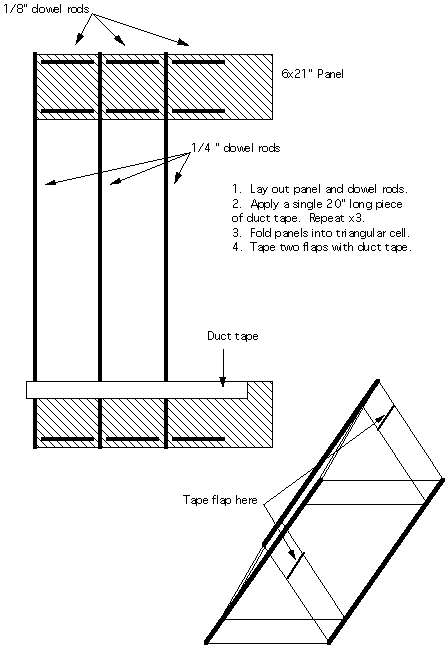
The Pit and the Pendulum and Simple Harmonic Motion
by Brion G. Patterson
Rappahannock Co. High School
Sperryville, VA 22740
bpatters@mwc.vak12ed.edu
The Pit and the Pendulum, by U.Va.'s Edgar Allan Poe, is not only
a vivid and suspense filled short story, it is also a gripping
physics situation. I recently borrowed the idea of using The Pit and
the Pendulum from a project carried out at Mission High School in San
Francisco. My students first investigated the effects of mass and
length upon the period of a pendulum. For example, students first
predicted the relationship between length and period. Then they
determined the pendulum lengths necessary to obtain periods of 0.6,
1.0, 1.6, Z.0, and 2.3 seconds. Graphing their data, they found they
had a parabola (confirmed by graphing the squares of the periods and
obtaining a straight line). Thus they created their law: pendulum
length is directly proportional to the square of the period, or L = c
T2. The value of the constant c can be determined.
Then, as a class, we read aloud The Pit and the Pendulum (the
activities of the Inquisition evoking memories of Galileo's trial. We
read right up to the point at which the prisoner has smeared his
bonds with meat to attract the rats--but I withheld the final page
which revealed whether escape from the pendulum was achieved. At this
point, the key data had already been provided: the pendulum is about
30 feet long, the descending pendulum blade is within 10 to 12
periods of reaching the prisoner, and the rats need 1 minute to cut
through the bonds. Substituting values for length L and constant c
into the equation, we determined that the fateful pendulum has a
period of 7 seconds (note c = 9/4 pi squared) The ten oscillations
available before our prisoner is cut will provide about 70 seconds:
the rats have time! The prisoner will escape!
Gyro's from Junk
Tony Wayne
Albemarle High School
2775 Hydraulic Road
Charlottesville, VA 22901-8917
wayne@uva386.schools.virginia.edu
Wouldn't it be great to have a battery powered gyroscope when
discussing rotational inertia? The parts for making one can be found
in an broken radio with a cassette mechanism in it. A walkman, car
radio, stereo or boom box with a cassette player will work. (Yard
sales usually offer radios for about $5.00). Under the cavity where
the cassette is inserted is a flywheel and dc motor. The flywheel
will vary from mechanism to mechanism. Generally the flywheel is made
of aluminum and ranges in size from that of a quarter to a silver
dollar.
When the flywheel comes off the cassette mechanism, expect to pull
its shaft out with it. There is a little lock washer -of sorts- on
the opposite side from the flywheel that holds the flywheel's shaft
in place. Once this is pried off with a small screwdriver, the shaft
will slide out easily.

Place the flywheel in a vice as shown. Close the vice as much as
possible without clutching the shaft. Take a #6 nail and a hammer and
punch out the shaft. There is usually a small brass fitting in the
center of the flywheel. The quarter inch flywheel can pop out with
the shaft if everything is not done carefully.
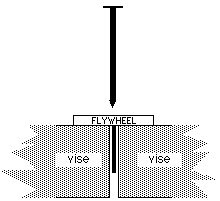
Pull off the small pulley wheel on the motor. The dc motor is usually
attached with 3 screws and is easily found. Unscrew these screws to
remove the motor. Place the flywheel on a flat, heavy,
secure base. A cement floor works great. With the motor upside-down,
hold the motor's shaft over the flywheel and lightly tap it in with a
small hammer. Be careful, if the work surface bounces any the motor's
shaft can be bent.
Also, if the motor's shaft is driven too hard into the flywheel, it
will bend.
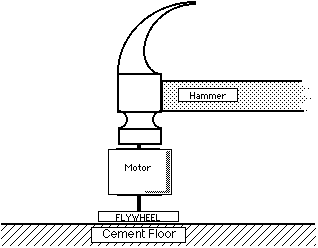
Now just connect the motor via 2 long wires to a battery holder and a
switch. Install the batteries, hold the motor and feel the inertia.
Make several with disks of different rotational inertia and examine
the times it take for a disk to reach its top speed.
Recently I found a hand held mini-fan at a dollar store. The fan
motor's shaft was the perfect size for flywheel. It looks so
professional.
Below is a picture of the insides to a "Walkman," actual size.
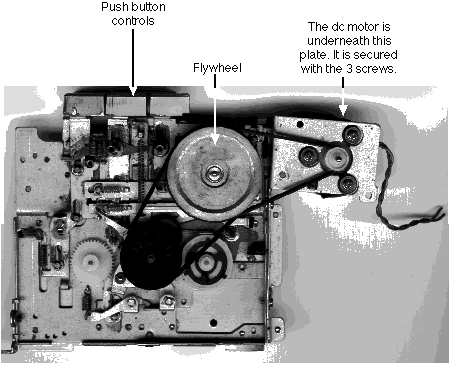
"Seeing the Light" Electrostatics
Demos
by Tony Wayne
1. Electrical path with a flare of fluorescent
This demonstration was presented at the last VIP meeting by Jackie
Hardy.
Materials
- Fluorescent light
- High output Tesla coil
- Alligator clip with attached wire
Process
Attach the alligator clip to the Tesla coil with the coil turned
off. Skin off about a foot of insulation from the other end of the
wire. Wrap this end of the wire TIGHTLY around the your bare
angle. Turn on the Tesla coil. (If the wire isn't tight around
your angle, the your will constantly get the urge to dance from an
electrical pricking.) Grab a fluorescent bulb. Touch the other end
to the plumbing and watch it glow. Slide your other hand along the
bulb. Have a student grab the end of the bulb -no pain is
involved. The bulb is glowing only between your hands or your hand
and the student's hand. The Tesla coil is a source of high energy
electrons. When you grab the light bulb it gets your high energy
electrons. No light is present. When a student grabs the bulb the
electrons have a path to travel. When the electrons move they
generate a current. You need a current for the bulb to light.
2. Electrical path with novel neons
I recently saw a neat version of this in January, 1993, issue of
The Physics Teacher . You need a difference in electrical
energy for light to light up. Once this difference is established the
electrons flow and viola.
Materials
- Neon bulb (Radio Shack stock number 272-1101 or 272-1102
-$0.69)
- A stretch of carpeting or a TV screen
Process
Give a student a neon bulb. Have the student slide their sock feet
across the carpet. This will give them a source of high energy
electrons. Turn off the lights. The room must be VERY dark. Wait a
few seconds for the students eyes to adjust to the darkness. Have
the student touch a door knob. The bulb will glow as electrons
move through the bulb. These neon bulbs need a potential
difference of at least 85 volts.
3. Electrical path in a flash
Materials
- 2 Alligator clips
- Stretch of carpet
- Flash bulb: Buy a flip flash unit (10 bulbs in one piece).
Tear apart the unit and cut out the
bulbs. Make sure you get as much lead off the bulb as you can.
Process
Attach the alligator clips to both leads -this is for safety. Keep
the lights on. Give student the flash bulb. Now have the student
slide their socked feet across the carpet. Touch a door knob with
the other alligator clip. The bulb will flash. The bulb will melt
where there is a blue dot. The alligator clips are used to keep
the melting bulb away from the students hand. Flash bulbs like
this are used for igniting thermalite inside of high powered
rocket engines -not the A-D Estes engines.
Non-Newtonian Fluids Update
by Tony Wayne
Albemarle HS
2775 Hydraulic Rd
Charlottesville, VA 22901-8916
wayne@uva386.schools.virginia.edu
If you remember last may we features an article from Jackie Hardy's
class about non-newtonian fluids. Below is a blurb about a use for
non-newtonian fluids by a writer on internet.
A 4-wdr Subaru also makes use of a neat non-Newtonian fluid. The
front (driven) wheels are connected to the rear set via a housing
containing two plates and the fluid. As soon as the fluid is
subjected to a differential rotation (the shear stress), the
viscosity immediately increases tremendously, essentially locking the
two sets of wheels. I find that one loses about 2 mpg due to normal
motion within the fluid when in 2 wd.
by RUSS HARKAY
Since last spring, I have stumbled across the two recipes for
non-newtonian fluids -found elswhere in this newsletter. If you want
a copy of the orginal article from last spring's newsletter send me a
self-addresses-stamped envelope or contact me through e-mail.

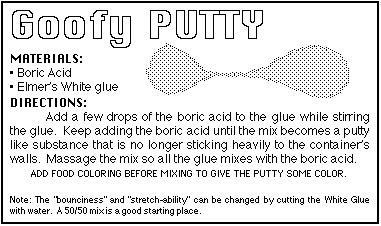
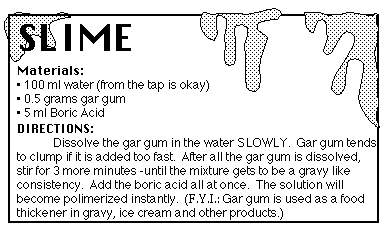
|